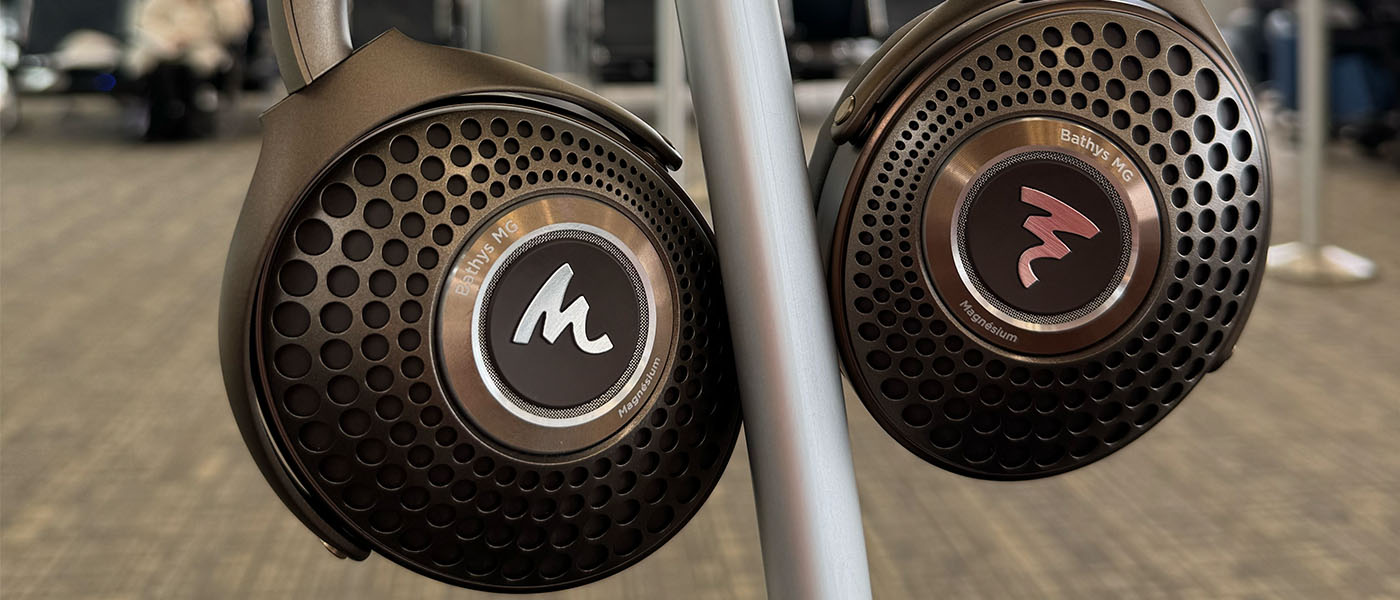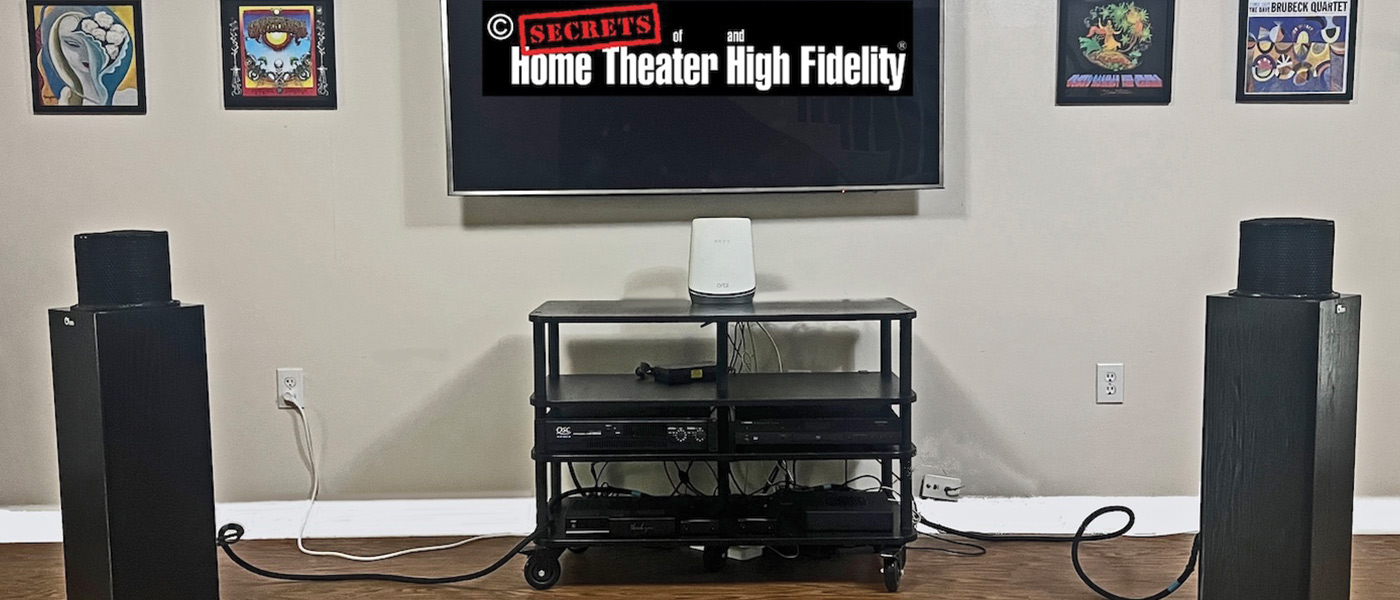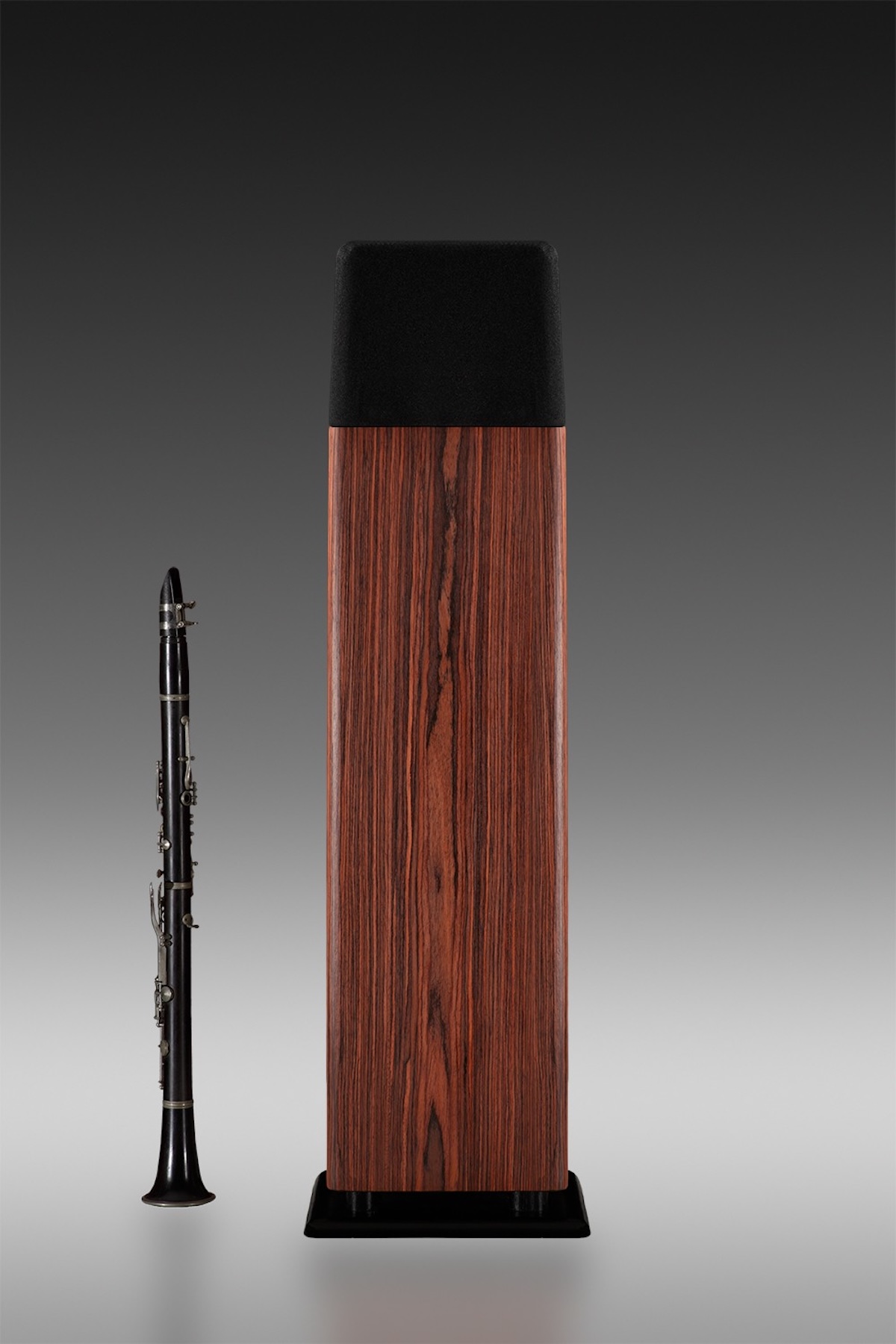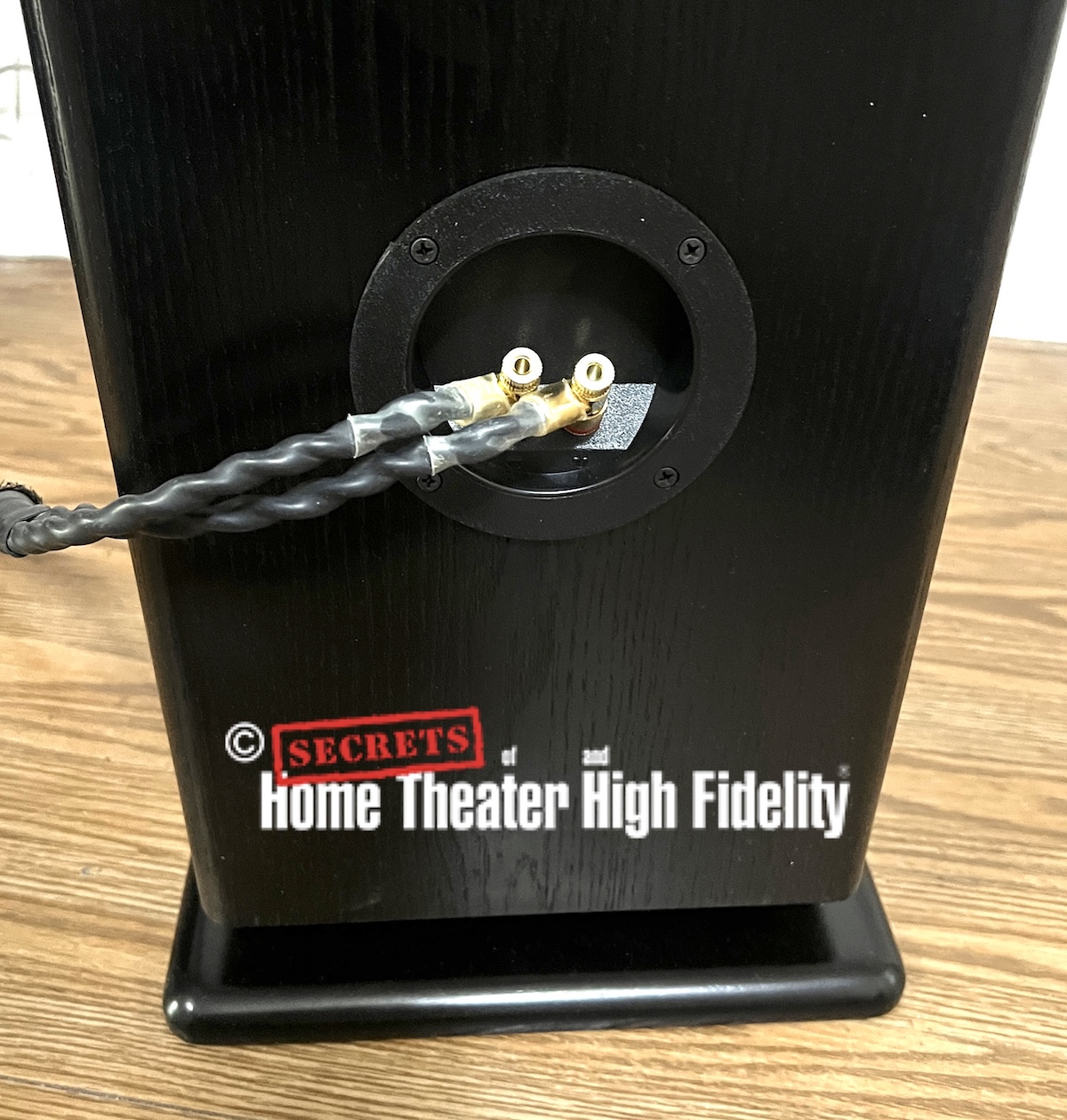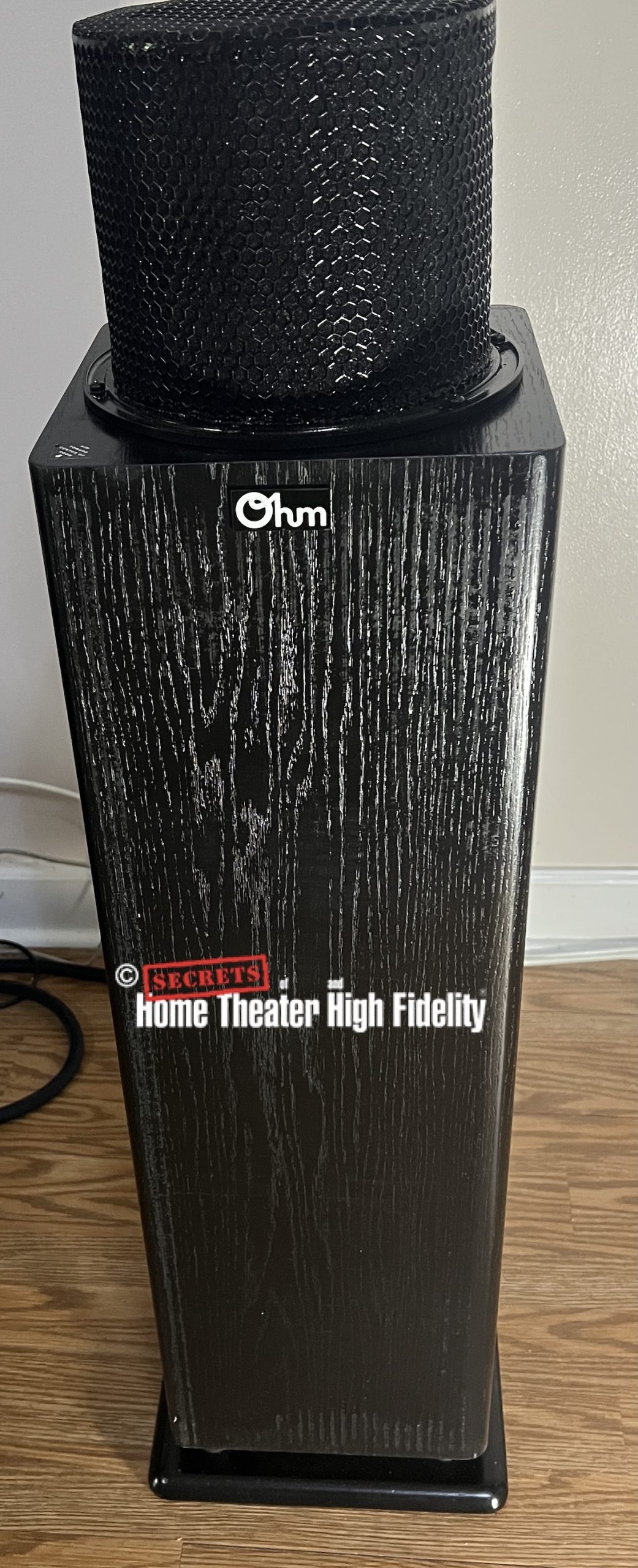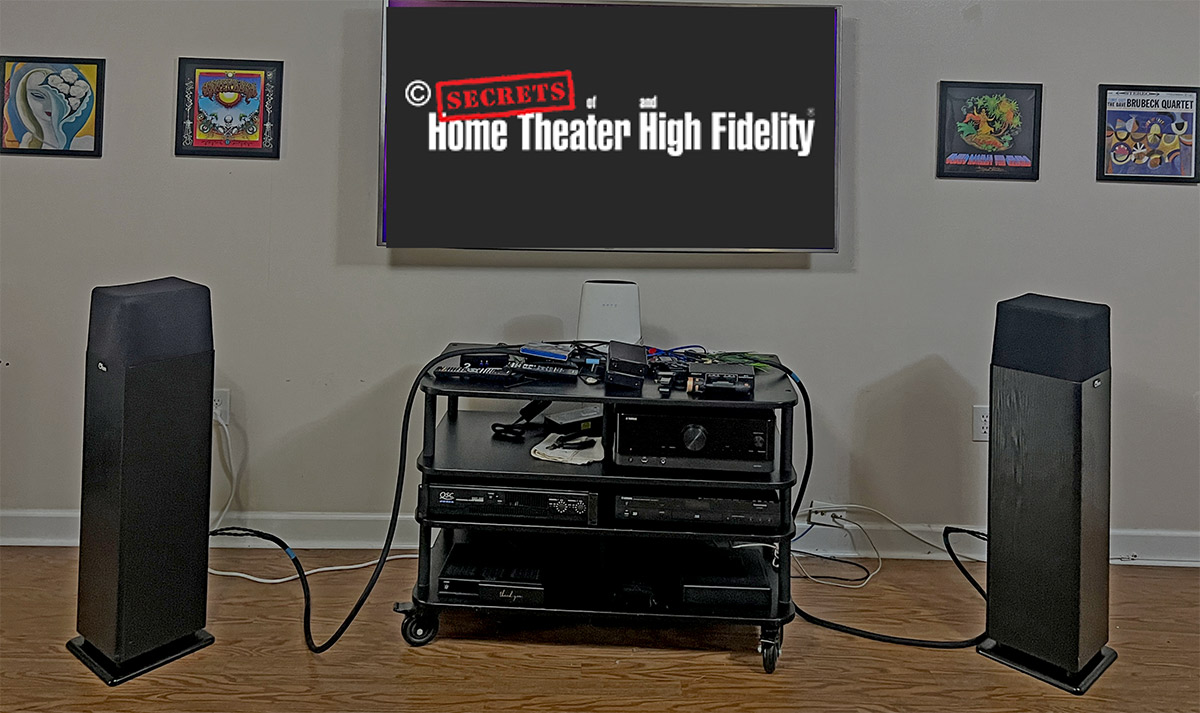By deliberately using the room as the means of propagating a coherent source, the Ohm 2000 speakers lack the “head-in-a-vise” sweet spot that most speakers require. The Ohm 2000 speakers are just great “crank-it-up” fun!
The 2000 speakers offer a unique sonic experience that is otherwise unavailable not only in this price range, but also for any amount up to 10x the price of the 2000s (with the possible exception of the Orion LX Sirius speakers). Omnidirectional speakers have traditionally been both expensive to purchase and expensive to drive, often requiring amplifiers of prodigious power and price (Threshold and Krell come to mind). But it seems that Ohm has overcome the usual technical and financial challenges of manufacturing omnidirectional speakers and passed the savings on to all of us!
OHM 2000 TALL SPEAKER
- Can be used in (mostly) untreated rooms
- Have attractive cabinets and grills
- Can image with the very best of conventional speakers
- Listeners can wander the room and still get imaging (although not as precise as in the “sweet spot”)
- MAJOR improvements in speaker performance can be had by positioning
- 120-Day trial period
- 5-year (non-transferrable) warranty
I was in a state of profound cognitive dissonance when the review pair of 2000 speakers was delivered. I placed the 2000s in my living room and, after the usual Stereophile channel identification and phasing tracks, put them to play. And?
Having read extensively on the internet about omnidirectional speakers, I had a long list of expectations – many of which may have been wrong or at least misleading! But the 2000s also offer a long list of virtues, too, many of which I’ve not seen mentioned in other reviews.
I had expected, as discussed in the 2000’s user guide, that the wall behind the speakers should be reflective, not absorptive. So, before the speakers arrived, I meticulously peeled off my sound absorber panels and cleaned the wall so that the Ohms would have their desired clean, hard surface from which to reflect.
I had an audio amigo and master-quality “speaker dancer” assist me. We placed the 2000 speakers where they sounded their best. My preconception was that so long as the wall behind the Ohms was reflective, their position didn’t really matter too much – this was wrong!
The Ohm literature states that the 2000s should be between six and 24 inches from the wall behind them. I started at six inches, and I can tell you that at six inches, or even at 24, the bass produced by the 2000s (in my room) is muddy and slow. Note that this result was in my room. Other rooms may respond significantly differently!
So, I began moving the 2000s out from the wall. At about 36 inches, there was a lot less bass by amplitude, but what remained was tight, articulate, and pitch-perfect! An audio amigo pointed out that these speakers would benefit from a subwoofer. Why? Because when placed where the 2000s imaged the best (far from the wall behind them), the speakers also lost the bass reinforcement of having a nearby wall. This characteristic is NOT unique to the 2000 speakers!
I was also under the impression that the right-to-left acoustic properties of the room would not be of concern. Wrong! My wife’s leather recliner on the right side of the room threw off the center image profoundly until I pushed that recliner far enough back that I got a smooth soundstage across the front of the room.
Despite the “88dB/1W/1m” rating of the 2000s and their nominal 6-Ohm impedance, my Yamaha AVR (RX-V6A model) was not a good choice for driving the 2000s. The combo was dynamically flat, and the bass was mushy and undefined. I replaced the Yamaha with my QSC RMX850 “pro” power amp, and the bass became significantly tighter. And, as an added bonus of the stronger amplifier, the soundstage really opened up! I then tried my Fosi V3, Class-D mono blocks, and the 2000s’ bass got even better yet!
The 2000 speakers claim a -3dB point of 36Hz. Near-wall placement is critical in getting that performance. What might work for you, I can’t predict, but were I to be so brash as to offer advice for better bass, that advice would be “bring watts!”
During the preparation of this review, I have had the opportunity to consult Mr. Evan Cordes of ohmspeaker.com. Being as irritatingly focused as I normally am, I asked Evan multiple questions regarding the 2000 speakers. Among those:
Question: For a portion of my review, I’ll be using a Yamaha AVR to assess the 2000 speakers in cinema use. The AVR has a microphone with room-correction software. Does Ohm recommend the use of room correction?
Question: It seems to me that the 2000 speakers, being omnidirectional, wouldn’t particularly need a center channel speaker for movies, yet I see that Ohm offers one. How important to movie dialogue is the center speaker? Could another center be substituted, or is the Ohm center uniquely suited?
(A) You’re having trouble understanding dialogue.
(B) The sound stage is drifting off-center as you listen from more remote parts of the room or…
(C) You want to place the main left and right speakers very far apart.
None of these is what Ohm would consider to be “normal circumstances.” Still, many people want to use a center speaker if for no other reason than that their electronics allow them to. (Three-channel stereo can also be a very satisfying effect, but 99% of the center speakers we make are for home theater.)
We generally recommend using the same make and model for the front three speakers (L-C-R) to keep the voicing and soundstage consistent. This allows the main speakers to do what they do best. However, some customers do use other brand center speakers.
For rear surrounds, we make a wall-mounted speaker with a modified version of our normal Walsh driver that directs the sound energy to bounce around the room before it reaches your ears, obscuring the exact position of the speaker and producing a more immersive – instead of distracting – effect on movies.
Question: The primary cone of 2000 speakers responds to signals from the lowest bass to 8kHz. Over such a range, there must be significant intermodulation (IM) distortion. How does the 2000 speaker make it less audible?
NOTE: (wave-bending is the phenomenon where waves change direction when transitioning between different mediums (refraction), such as when a wave on the cone of the speaker encounters a different material, such as the speaker’s suspension)
Question: Why doesn’t Ohm use ribbon tweeters?
Question: Is the amplifier directly coupled to the 2000’s speaker cone, or is there a crossover in series?
Comment: Pay particular attention to Mr. Cordes’ claim about how the 2000’s frequency peaks and valleys are smoothed by the room reflections. I was highly skeptical of this claim until I heard it for myself, but it is ABSOLUTELY TRUE! Whether positioned closer to the wall or out into the room, the 2000 speakers are some of the flattest I’ve ever heard. This is most evident from the mid-bass through the lower treble (although both are somewhat dependent on placement). I don’t mean flat in dynamics, but rather flat in frequency response! No single note or narrow range of notes sticks out, ever. Placement can add or subtract to broad ranges of notes, such as the bass or treble, but NOT to narrow-band “room echoes.” This ability is nothing short of miraculous, particularly in an untreated room!
Question: I understand that the amount of bass produced by an Ohm speaker is a direct function of the speaker’s distance from the back wall. Does moving the speaker toward that wall also affect the bass frequency extension?
Rec. Room Size:
1,800 and 3,000 cubic feet
Frequency Response:
36-20kHz. +/- 3dB.
Rec. Amplifiers:
From 40-200 Watts / Channel
Sensitivity:
88dB / 2.8V (1W) / 1m
Dimensions (W x D x H):
9.5 x 9.5 x 39 inches
Available finishes:
(Standard) – Walnut, Cherry, Oak
(+ $50/speaker) – Maple, Sapele
Impedance:
~6 Ohms
Weight:
65 lbs. / 29.48 kg.
Price:
$1,900 ea. (standard finishes)
Shipping:
$100 ea.
USA Telephone:
800-783-1553
Outside the USA:
718-422-1111
eMail:
Address:
Ohm Acoustics Corp.
135 S. Main St.
Thomaston CT 06787
Warranty:
5 years from date of purchase. Warranty is non-transferable.
Dealers:
None – All purchases are factory-direct
Company:
SECRETS Tags:
OHM, Ohm Acoustics, WT-2000, 2000, TALL, SPEAKER, TALL SPEAKER, Floorstanding Speakers
HOW DO OHM SPEAKERS WORK?
The 2000 uses a single 8” driver per side. These drivers fire downward into the speaker cabinet with a port at the bottom that vents through a built-in riser-stand. For the 2000, each 8” driver covers almost the full frequency range (from low bass to 8kHz). A 1” soft-dome super-tweeter is mounted at the top. The super-tweeter axes are normally crossed in front of and above a seated listener. This pair of drivers covers the entire frequency range from bass to 20kHz.
Having owned multiple two-way speaker systems over the past decades, I can say that the 2000s sound superior to and different from the usual multi-way speaker systems! With the 2000s, the entire audio range, from the lowest bass to 8,000 Hz, is reproduced by a single driver. The lack of crossover components in the middle of the audible range must be heard to be appreciated!
I must also discuss the dynamics of the 2000 – If you are the type of listener (like me and my wife) who normally listens at low volumes (typically 60 to 65dB peaks), then this might not be the speaker for you!
Almost all speakers (except for those of exceptionally high sensitivity, such as Klipschorns and Tekton Design products) have a “volume threshold” that must be exceeded before the speakers can “come alive” and excel at dynamic contrasts. This is also true of the 2000. In fact, it seems that the louder you play these 2000 speakers, the more dynamics and detail they can deliver!
My wife and I tried using bass and treble tone controls, “Loudness” buttons, and DSP to compensate for the Fletcher-Munson effects of listening at such low volumes. Although equalization did help, the 2000 speakers still didn’t sound truly dynamic until their volume was increased to a minimum of 75-80 decibels. Above that level, the 2000s just kept getting more and more dynamic sounding!
At the other end of the volume continuum, most speakers also have a “loudness ceiling” above which the sound just becomes an undifferentiated roar, losing all dynamics. I’m sure that the 2000 speakers must also have such a loudness limit somewhere, but I was never able to find it. I cranked these speakers up (with amplifiers WELL in excess of 200WPC to avoid clipping), and the speakers just delivered more and more detail and better and better imaging without ever losing dynamics. Amazing!
ON THE IMPORTANCE OF PHASE-COHERENCE:
Phase coherence ensures that sound waves from different drivers of the loudspeaker arrive at the listener’s ear at the same time, with a consistent time relationship, across the frequency spectrum. Most speakers are not phase coherent. Even if a speaker uses a tilted- back baffle to approximate time alignment, the crossovers typically are not phase-coherent, destroying the entire speaker’s phase coherence.
If drivers are not phase coherent, destructive interferences may destroy the integrity of the original audio signal. Speakers without phase coherence can sound pleasant, but when you have heard a phase coherent speaker, then typical box speakers with drivers on a flat baffle board (I almost accidentally typed “babble board” that, ironically, would have been accurate too!) just won’t sound the same.
The Ohm speakers, regardless of model, are phase coherent from the lowest bass to approximately 8kHz. Virtually ALL music and voice materials are within this range, and it is all produced by the single, vertically mounted driver. This is a clever and very successful design.
Secrets Sponsor
THE OWNERS’ MANUAL STATES: “Place the loudspeakers 6 to 11 feet apart. The distance between the loudspeakers will determine the apparent width of the sound stage.”
THE OWNERS’ MANUAL STATES: “The loudspeakers should never be farther from each other than they are from the listener.”
THE OWNERS’ MANUAL STATES: “Place the speakers no more than two feet away from the front wall. The closer the loudspeakers are to a wall or corner, the louder the output will be in the range below 150 Hz.”
THE OWNERS’ MANUAL STATES: “For best imaging, the front wall should be reflective and dispersive – not absorptive.”
THE OWNERS’ MANUAL STATES: “If you want more treble, rotate the speakers outward. If you want less treble, rotate the speakers inward.”
ASSOCIATED EQUIPMENT USED FOR THIS REVIEW:
● Roon Nucleus One with SSD Library & TIDAL streaming service
● AudioQuest Dragonfly USB DAC
● HRT High-Definition USB-DAC
● Douk Balanced Tube Preamplifier
● Yamaha RX-V6a Audio-Video Receiver (~140WPC/6-Ohms)
● QSC RMX850 “pro” Power Amplifier (~250WPC/6-Ohms)
● Fosi V3 Class-D monoblock power amplifiers (~180W/6-Ohms)
● 65” wall-mounted flat-screen television between speakers
● Various name-brand USB cables, Ethernet cables, Interconnects, and Speaker cables
● Sound absorber [panels (behind listening position only)
● M&K VT-125 Mk. II Subwoofer (sealed box, self-powered)
● Emotiva Virtual Cu subwoofer transmitter/receiver pair

THE OHM 2000 SPEAKERS USED WITH MOVIES:
Ohm’s claim is that, depending on the size of your movie room and your surround sound proclivities, you may not need a center channel speaker, a subwoofer, or surround speakers (despite the fact that Ohm offers all of the above). I tested their claim with a Sci-Fi movie called Tenet.
My AV room is 26.5 x 16 x 9 feet with the 2000s on the long wall. In my room, the movie dialogue was very intelligible. Had I wanted to boost the dialogue track by a decibel or two in my AVR, I could easily have done so without a center dialogue speaker.
With the 2000s about 15 inches from the wall behind them, I got almost all the impact of explosions, trains, etc., without the use of a subwoofer. Really, if you need to skimp somewhere on your movie system, the sub may be the thing to do without if you’re using the 2000s, but don’t expect to get the shuddering bass that a good subwoofer can bring.
Surround? No, not really. If surround is important to you, I don’t think that the 2000 speakers will fake it enough to satisfy you. You’ll almost certainly want real surround speakers in the room.
THE OHM 2000 SPEAKERS USED WITH MUSIC:

Jennifer Warnes – “Somewhere, Somebody” from the album “The Hunter:”
In this track, a young man (Mr. John McEuen, I think) sings a duet with Ms. Warnes. On all “conventional speakers” that I’ve heard this track, Mr. McEuen’s voice is frequently obscured by the instruments and/or by Ms. Warnes’ voice. The 2000 speakers were not only able to make Mr. McEuen’s voice audible and his lyrics comprehensible, but also allowed some spatial clues as to where in the soundstage Mr. McEuen was located. This song (one of my favorites) has NEVER sounded better than on the 2000 speakers. But to get this level of detail, the 2000 speakers were placed four feet from the wall behind them and somewhat closer together than would be the case if the speakers and listener formed an equilateral triangle. The 2000’s tweeters were also rotated so that they were parallel to each other and at a 90-degree angle to the wall behind them. And finally, the volume had to be cranked up above the loudness at which I normally listen for the 2000s to perform their magic.
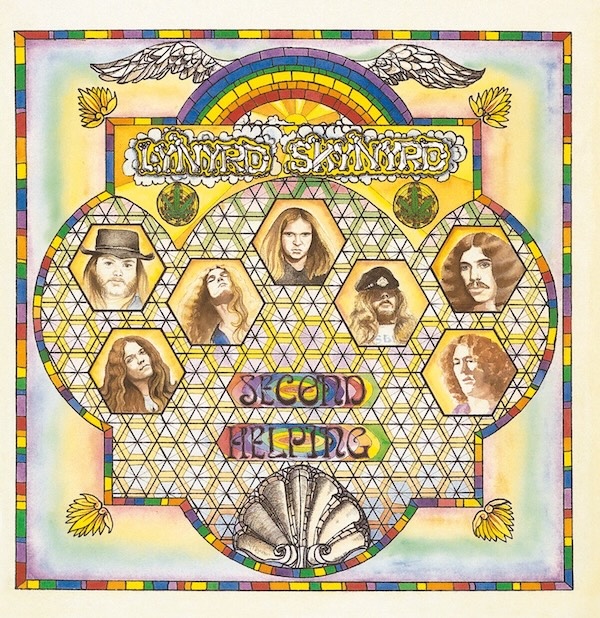
Lynyrd Skynyrd – “Call Me The Breeze” from the album “Second Helping:”
So, if you have a pair of “crank-‘em-up!” party speakers in the house, what do you play? I chose to go with the guitar and piano jam of “Call Me The Breeze” by Lynyrd Skynyrd! And on this material, the 2000 speakers did NOT disappoint. The last time I’d heard this song, it was played on Klipsch La Scala speakers driven by VTL Compact-100 tube power amps. And as awesome as the VTL-Klipsch pair sounded, I got an even better reproduction from the 2000 speakers. The drums had greater impact, the cymbals rang more convincingly, and the guitars and piano were so addictive that more than once, I got lost in the music and forgot to keep taking notes. It just doesn’t get any better than that – but, again, to get this level of verisimilitude, I had to crank the 2000 speakers louder than I normally listen. I’ll also note that for this song, I had the AudioQuest Dragonfly DAC connected directly to the inputs of the Fosi Class-D mono amps.

Steve ‘n’ Seagulls – “Over the Hills and Far Away” from the album “Farm Machine”
The band “Steve ‘n’ Seagulls” from Jyväskylä, Finland, is one of my secret vices. Although the bulk of their work is covers of popular songs, they always throw in a few works that I’ve never heard before. And so it is on their “Farm Machine” album. The “Over the Hill and Far Away” cut (a cover) blows in with fast banjo work and never lets you catch your breath!
Through the 2000 speakers, the presentation was breathtaking (again with the speakers 36” from the wall behind and cranked up to party levels).
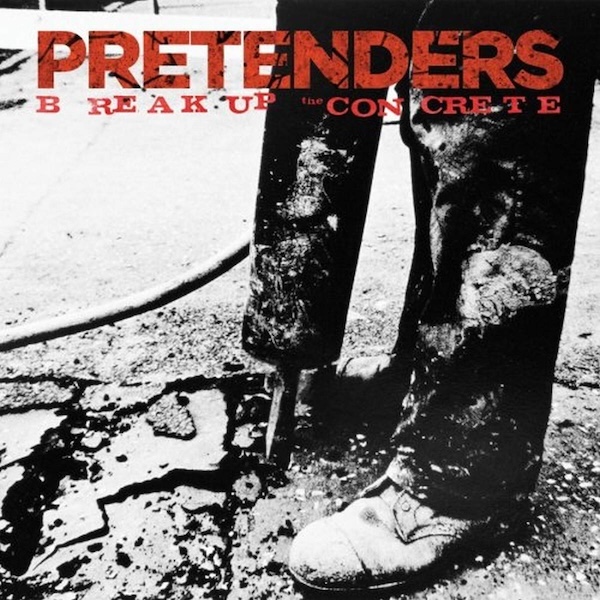
Pretenders – “Break Up The Concrete” from their album of the same name
Percussive singing (and cool guitar solos in the background) make this tune a fun choice for speaker testing. The 2000s don’t disappoint. They startle you again and again with the dynamics that most speakers just don’t have at ANY volume. Surprisingly, this cut sounded good with the speakers out into the room AND with the speakers near the wall behind them. The song also sounded good at both low and high volumes! Why does this song (and, so far as I’ve found, ONLY this song) defy the 2000s normal proclivities? I don’t know, but I can assure you that it’s so.
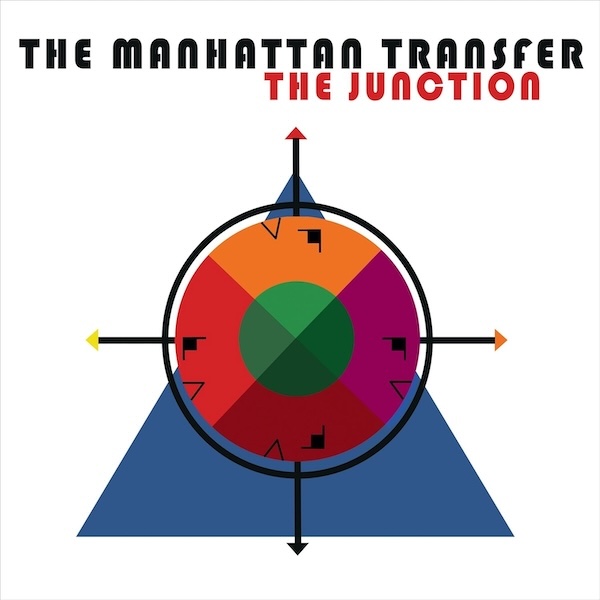
The Manhattan Transfer – “Cantaloop (flip out)” from their “The Junction” album
This song takes a while to get going, so don’t play the first minute and then ditch it. You should be able to point your finger at the location in the soundstage where each singer stands. Imaging is THAT specific. But to get this soundstage, you must (again) get the 2000 speakers away from the wall behind them and play with toe-in/toe-out until you hit the spot where the image coalesces (you’ll hear it when it does!).
LISTENING PANEL FEEDBACK:
During the review, this reviewer had several groups of my “audio amigos” come by to listen to the 2000 speakers and give their comments. The following are comments from the listening panels:
● Speakers in this price range should not require the use of subwoofers.
Reviewer’s Comment: I personally understand this sentiment, but since ALL speakers are usually positioned for the best imaging, and since that position is not usually the best position for bass generation in the room, I don’t consider this need for a subwoofer requirement to be onerous.
● After three or four listening sessions, agreement was reached that in my 25.5 x 16 x 9-foot listening room, the best performance from the 2000 speakers was obtained:
- With the back of the speakers 48” from the (long) wall behind them
- With the tweeters of the speakers slightly toed out away from the listeners
- With the speakers approximately 10 feet apart from each other
- With listening volumes of approximately 80-90 dB
- With a full-range signal feeding the speakers (no bass management)
- And with the M&K subwoofer “blended in” below the speakers
Secrets Sponsor
The Ohm 2000 loudspeakers are an American-designed and made loudspeaker of unique omnidirectional design, WITH a 120-day trial period and WITH a 5-year warranty! Decidedly different, unconventional, and brilliant!
- The quality of the wood finishes is amazing
- There is a 120-day trial period during which you can return the speakers for a full refund
- Properly set up, the speakers give the most holographic imaging I’ve ever heard
- Better low-volume dynamics
- User-adjustable tweeter direction
The 2000 speakers can offer some of the most realistic performances I’ve ever heard in my listening room. If you are interested in movies, the 2000s are a “no-brainer” recommendation. For music, the still-strong recommendation is conditional – If you’re willing to attend to speaker placement, if you’re willing to play the speakers reasonably loudly, and if you’re willing to include a subwoofer, the 2000s should reward you with the best imaging ever (and without expensive room treatments).


